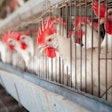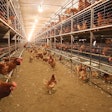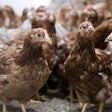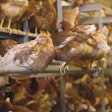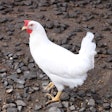
While recent outbreaks of African swine fever have highlighted biosecurity in the swine sector, diseases such as highly pathogenic avian influenza (HPAI) have also made biosecurity critical on poultry farms. The following four tips can help promote biosecurity, support flock health and protect profits.
1. Mandate farm management practices
Whether in a developing region or a sophisticated production environment, be it chicken meat or egg production, biosecurity begins on the farm. A “line of separation” distinguishing the poultry farm from the outside world is the most basic starting point. Fencing the farm’s perimeter creates a “clean-dirty” line of defense against pathogens.
Because humans present the greatest biosecurity threat to poultry, basic practices for minimizing contamination risk include having all visitors complete a ledger. This documentation is valuable in the event an issue demands traceability. Visitors’ biosecurity safeguards should include: showering before entering the poultry house, putting on farm-specific, flat-soled boots or protective covers and requiring visitors to wear protective coveralls. A disinfecting bath should be placed in each bird house.
All-in-all-out (AIAO) production that keeps birds together across all life phases should be standard practice. When one group moves forward, litter should be changed and disinfection procedures completed before the next group arrives. Employees should care for younger birds prior to tending to older birds because the younger birds’ less mature immune systems make them more susceptible to diseases than older birds.
Consider how vehicles and housing can also compromise biosecurity risk. A disinfecting tire bath should be required for feed mill trucks and all vehicles entering the farm.
Depending on the production region, adequate distance - 50-500 meters - should exist between buildings housing flocks in different production stages. Inside the poultry house, high stocking density, fluctuating temperatures and poor air quality due to inadequate ventilation will contribute to stress along with conditions that heighten competition for feeder and drinking water access. Adjusting feeder and drinker heights gives birds easy access and helps minimize contamination. Avoid turning litter, but if litter must be turned, lift drinkers and feeders.
2. Assure feed hygiene
Without feed hygiene and preservation strategies, Enterobacteriaceae, molds, yeast and mycotoxins in raw materials and compound feed can easily make their way into feed on the farm. A feed mill scan can assess critical control points on microbial,colony-forming units and identify potential pathogenic threats in raw materials, process lines and compound feed.
Every quality control program should include regular sampling of raw materials and cleaning of process lines, silos and feeders on the farm. Residual biofilm in process lines should be stripped away. Feed ingredients – especially processed raw materials – should be periodically analyzed for common microbial risks. Treating these materials with buffered and synergistic blends of organic acids and surfactants can support hygiene and strengthen the natural barrier against gram- bacteria in the first part of the digestive tract. Furthermore, mycotoxins can now be analyzed on the farm within minutes to establish effective risk mitigation.
As formaldehyde has been banned as a feed hygiene enhancer in many countries, an integrated approach to feed hygiene is essential. This approach combines risk assessment, feed hygiene actions and preservation strategies including application of buffered and synergistic blends of organic acids and surfactants.
3. Assure drinking water quality
Resulting from microorganisms inside pipes and storage tanks, biofilm can appear on the inside of water pipes and nipple lines. Biofilm accumulation may clog drinking nipples, screens and filters, disrupt water flow, and serve as a source for pathogenic microorganisms to reproduce.
To counteract biofilm and disinfect, farmers can use hydrogen peroxide, flush with water or use chlorine and/or organic acids. Hydrogen peroxide is very effective in counteracting biofilm and it is commonly the chosen treatment for in-between cycles – always followed by flushing. Flushing should follow any treatment (antibiotics, vaccines, vitamins, etc.) used in water. While highly effective, chlorination’s efficacy demands careful attention to dosing (effectively chlorination is pH dependent). Free chlorine levels should be checked daily. Target levels should be in the range of 3-5 ppm, and the oxidation reduction potential around 650-700 mV.
Water acidification via drinking water additives can decontaminate water and support bird health. Water acidifiers reduce the pH of water below 4, at which many Gram-negative bacteria struggle to survive. Additionally, at stomach level, undissociated forms of the acids have a bactericidal effect on Gram-negative bacteria that reach the stomach via contaminated feed or feces. Primarily for young birds, a lower pH supports better protein digestion, as pepsin (a protease) is most active at a low pH. Less undigested protein reaching the hindgut and microbial control in the stomach results in improved performance and a healthier gut. A screen for Enterobacteriaceae, molds and yeast should be a standard practice.

Drinking lines must be kept clean to ensure that water is not contaminated. (Courtesy of Trouw Nutrition)
4. Protect gut health
While the highest biosecurity threat to flock health occurs when new checks arrive, risks occur across flocks’ lives. Although largely external, biosecurity is also linked to activity taking place inside the gut. Feed and drinking water additives can contribute to stronger internal defense against pathogens. Special organic, acid blends can help support a healthy microbiota, improving gut integrity and immunity.
Minerals also contribute to fighting gut bacteria. For example, feeding high levels of copper (where allowed) has been shown effective at flushing bacteria from the hind gut, where most pathogens collect. Hydroxychloride zinc helps strengthen the gut lining to protect against pathogens entering the gut.
Poor biosecurity can raise mortality rates posing challenges that include decreased uniformity, poorer chick quality, lower fertility rates, and diminished growth. Several countries have shown improving biosecurity helped control Avian influenza while supporting better performance and lower antibiotic use.

An immature gut makes younger birds more susceptible to disease than older birds. (Courtesy of Trouw Nutrition)
The economic case for biosecurity – an example from the US
In 2014-15, an outbreak of highly pathogenic avian influenza (HPAI) in the U.S. affected 211 farms depopulating poultry farms of 48 birds. The outbreak resulted in $990 million spent by the USDA Animal Plant Health Inspection Service (APHIS) on response efforts and was linked to a $5 billion impact on the economy.
The outbreak’s financial consequences inspired stricter biosecurity practices including new rules requiring US poultry producers to be audited biennially for biosecurity. In addition, the National Poultry Improvement Plan outlined a set of biosecurity guidelines available at www.poultryimprovement.org.
How to properly implement poultry farm biosecurity plans
https://www.wattagnet.com/articles/35969






